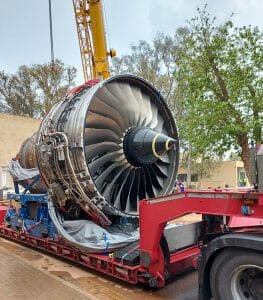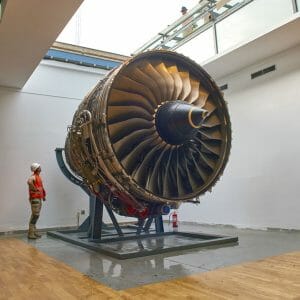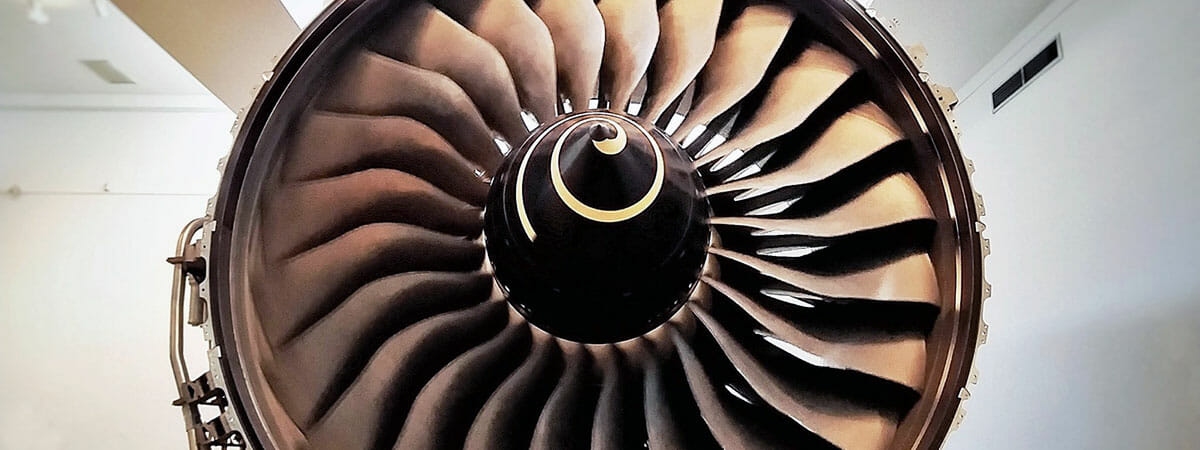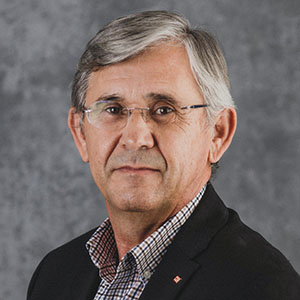If we look north from Malaga, approximately 1,800 kilometers away, we could well glimpse the keep of the castle of the city of Stafford, perched on a small hill in the English countryside.
From it we gaze at a large stretch of the green horizons that make up the East Midlands region. A place where the average monthly temperature ranges between 2 and 21 degrees Celsius and rain falls practically every week of the year.
One of the first Trent 900 engines developed for the Airbus A380 is already on display at Malaga Airport’s Navigation and Air Transport Museum. This is its interesting story.
It is this permanent precipitation that shape the small streams that make up the Trent River, one of the largest in the United Kingdom, and the natural border between the north and south of England.
There are many who attribute a Celtic origin to the place name Trent, whose meaning could well be “flood”, something to which Malaga residents are also accustomed to due to the proximity of the Guadalhorce River.
In its odd northbound course, the Trent River flanks the city of Derby, an important railway center and headquarters of the Rolls-Royce company.
The Rolls-Royce company was created in 1906 by Henry Royce and Charles Rolls, engineers, inventors and industrial entrepreneurs from the automotive world. Charles Rolls was also an aviator[1].
In 1914 Rolls-Royce manufactured what was its first aviation engine, the Eagle, a V-twelve-cylinder combustion engine capable of developing 225 hp and which equipped British planes in World War I.
Three decades later in the 1940s, the first production turbojet, the RB.23 Welland, left its factory, equipping the Gloster Meteor, followed by new radial compressor models and later axial compressor models.
At the end of the 1940s, the RB.80 emerged from the design benches, the first axial-flow turbofan with just over 76 kN of thrust.
The RB.80 definitively ushered in a new stage in aeronautical propulsion technology, transforming the original closed combustion cycle engines into the new continuous flow engines.
To name the jet engines, British engineers looked for an allegory that would be identified with the new propulsive technology, eventually finding in the flowing rivers the perfect metaphor for their continuous flow engines. This concept led to the birth of the names Welland, Derwent, Nene, or Avon.
In this case, the nearby Conwy River, a Welsh place name spelled Conway in Anglo-Saxon diction, was the name used to baptize the new design: the RB.80 Conway.
Half a century later, in the mid-1990s, the new requirements of the aeronautical industry, especially Airbus, knocked on the door of Rolls-Royce to promote the design and manufacture of a new engine.
The new engine was to equip what would be the largest commercial aircraft on the market, ultimately named the A-380. It was now that the nearby Trent River would give its name to a family of new generation engines.
In the case at hand, the Trent 900 inherited the development of its predecessors, the 700, 800 and 500, and has not only been a major scientific and technological challenge, but also an industrial one. Joining Rolls-Royce on this frontier of propulsion knowledge is Spain’s ITP (Industria de Turbo Propulsores), who manufacture the low-pressure turbine; Hamilton Sundstrand, responsible for electronic engine controls; Avio S.p.A., in charge of the gearbox module; the Marubeni Corporation, responsible for various engine components; Volvo Aero, who supply the intermediate compressor cavity; the Goodrich Corporation, specializing in various fan elements and sensors; and US giant Honeywell, responsible for pneumatic systems.
Also part of the program are Samsung Techwin, Kawasaki Heavy Industries and Ishikawajima-Harima Heavy Industries, an example of the globalization of international aeronautical technological development.
The Trent 900
At 5,478 mm long and 2,950 mm in diameter, the Trent 900 is a propulsion giant, a high-bypass turbofan (8.5-8.7:1), with an overall pressure ratio of 37-39:1.These characteristics allow the engine to reach a thrust between 300 and 400 kN. Its diameter is equivalent to the fuselage of a DC-9 aircraft.
The Trent 900 were first fired on March 18, 2003 and first flew on an A-340 flight test bed on May 17, 2004, earning EASA certification on October 29, 2004 and FAA certification on October 29, 2004. December 4, 2006.
Its first flight in the A-380 MSN001, registered F-WWOW, took place on April 27, 2005.
Of the different types of engines powering the Airbus 380, the Trent equips the 841, 842 and 843F models, all of them capable of attaining cruise speeds of 0.85 Mach.
And among the many technological contributions of the Trent 900, perhaps the most important are the reduction in fuel consumption, NOx and noise emissions.
The fan’s 24 titanium blades incorporate a new sweep design that reduces the effect of shock waves when the fan tip rotates at supersonic speed. In layman’s terms, the blades can withstand the equivalent force of 9 buses hanging from each of them.
The fan housing is also made of titanium, replacing the traditional Kevlar.
The LP compressor (fan) is made up of one stage, the IP compressor features 8 stages and the HP compressor 6 stages, feeding an annular combustion chamber.
The single-stage HP turbine is counter-rotating, which allows it to improve combustion efficiency by 2%, its specific consumption being 16 g/kN-s. The IP turbine is also one stage and the LP turbine features five stages.
The dry weight of the engine is 6246 kg.
From Toulouse to Málaga
It was October 2005 when one of the British Trents arrived at the Airbus facilities in Toulouse, where the brand new engine was mounted on one of the A-380 test aircraft that the European manufacturer had prepared, the MSN002.
 On October 25, Airbus conducted its first test flight and in the following months it changed its aircraft model (MSN002, MSN007, MSN002, MSN004 and MSN001), as well as its position on the wings (from one to 3, to 2, to 3 and back to 2).
On October 25, Airbus conducted its first test flight and in the following months it changed its aircraft model (MSN002, MSN007, MSN002, MSN004 and MSN001), as well as its position on the wings (from one to 3, to 2, to 3 and back to 2).
Its last flight took place on July 3, 2017, having flown 529 flights and having performed almost a hundred other operations on the ground, adding a total of 1,796 hours and 19 minutes of operation in its 724 ignitions.
After taken down for the last time from the wing of the MSN001, the engine was left to await an unflattering future that would see dismantling of this jewel of 21st century engineering.
But chance, and above all, the interest of Álvaro Rojas Zamora, a young engineer from Malaga for this “old” jet engine, opened up a future scenario full of flashes and admiration for this engineering marvel in an aeronautical museum.
It was the first rainy days of autumn 2018 when the possibility was raised for the Trent 900 engine to travel from Toulouse to Malaga.
A practically impossible project at that time, surprisingly 100 years after another feat that had already linked Toulouse with Malaga aeronautically.
It was in 1918 when French engineer and industrialist Pierre Georges Latécoère imagined an airline that would fly from Toulouse to Casablanca, with stops in Barcelona, Alicante and Málaga.
The challenges were so considerable that the technicians consulted advised against the project, forcing Latécoère to utter a phrase that has become famous: “I have redone the calculations over and over again. The project is unfeasible. There is only one thing left for us to do: to make it possible.”
Driven by this same conviction, Álvaro Rojas, a Rolls-Royce aeronautical engineer, was the architect of the crazy endeavor, who on November 30 presented the first proposal to the British company to ship the Trent 900 to the Malaga Museum.
 In parallel, the first steps were taken in Malaga with the main Spanish aeronautical companies who could collaborate in the engine transfer project; unfortunately however, these did not bear the desired fruit.
In parallel, the first steps were taken in Malaga with the main Spanish aeronautical companies who could collaborate in the engine transfer project; unfortunately however, these did not bear the desired fruit.
All of 2019 passed without the project seeing any progress and, in March 2020, the COVID 19 pandemic completely paralyzed not just the project, but the entire world.
Reactivated in the spring of 2021, Aena alone took new steps to make what still seemed like a dream a reality.
Reports, emails and calls were under way during the first half of 2021, until all the necessary mechanisms between Rolls-Royce and Aena could be set in motion so that acceptance, transfer and reception of the Trent 900 engine at Malaga’s Museum of Airports, Navigation and Air Transport could be possible.
A full race of technological, logistical, construction, design, administrative, legal, … and of course also economic obstacles lay ahead.
For more than six months, the tireless work of the Friends of the Museum Association, Aena professionals and Rolls-Royce technicians modeled what was still a dream.
Finally, more than three years after the project began, the Trent 900 was packed, fit and secured onto a special vehicle that set off for Malaga on the morning of April 7, 2022.
The last flight of the Trent
On Friday, April 8 and against all odds, the company in charge of transporting the engine announced that it was in the middle of the Castilian plateau. If everything went smoothly, on the morning of Saturday the 9th it would arrive in Malaga. Four days ahead of schedule!
The reaction of the Friends of the Museum was immediate, and in just a few hours the arrival set of the engine was prepared, enabling the huge transport truck and its lead vehicle to enter the Museum bay without any incidents affecting its precious cargo.
On April 12, activities began early in the Museum. At 7:00 a.m., the company BTG Construction and Engineering began dismantling the roof of Room 3. An hour later, two Malaga companies, Metal y Forja and Grúas Raimundo, joined in, together with British Rolls-Royce Technical Support technicians. All of them were architects to the success of the project for their professionalism and good work.
After commendable joint work for 10 uninterrupted hours, the Trent 900 was able to make what had been its last flight, landing in this unique museum in Malaga on the banks of the Guadalhorce River.
Since this spring, Malaga has a new cultural and technological jewel. But beyond its public exhibition for the delight of aeronautics lovers, Rolls-Royce and Aena’s main shared objective is to promote science and technology education, bring aeronautics to young people and inspire their creative work. These are tasks that the Museum of Airports, Navigation and Air Transport has been working on since its creation, more than 25 years ago.

[1][1] Charles Rolls has the tragic honor of being the first Briton to die in a plane crash involving a powered aircraft, a Wright Flyer he was flying in the vicinity of Bournemouth on July 12, 1910, the tail of which detached completely in mid-flight.


